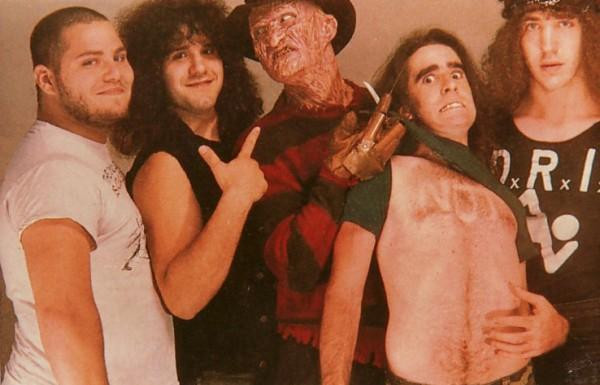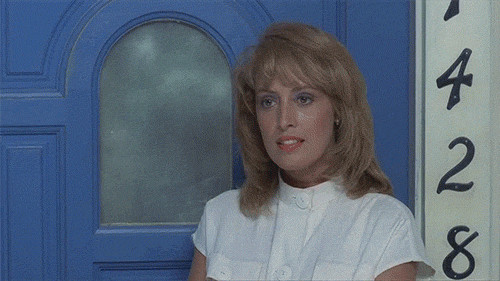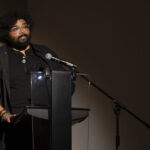For fans of horror movies, especially those who grew up in the 80s and 90s, the internet is a treasure trove. Remember a time before online communities, when expressing your love for something niche like the Nightmare on Elm Street soundtracks felt like a solitary passion? Back in the early 90s, finding someone who shared your enthusiasm for Freddy Krueger, let alone the music from those films, was rare. But the internet changed all that. Suddenly, you could discover you weren’t alone in worshipping Dramarama’s “Anything, Anything” or that there was a whole community dedicated to the sonic landscapes of horror cinema.
 Freddy Krueger's iconic grin, a staple of the Nightmare on Elm Street franchise, set against a blurred, fiery background, evoking the dreamlike terror of the films.
Freddy Krueger's iconic grin, a staple of the Nightmare on Elm Street franchise, set against a blurred, fiery background, evoking the dreamlike terror of the films.
Growing up, like many, I was more attuned to the prominent songs in movies rather than the instrumental scores. Catchy tunes grabbed attention, while scores often blended into the cinematic experience, becoming part of the atmosphere. Sure, some themes stood out – John Carpenter’s scores are undeniably iconic – but the focus was usually on the featured tracks. It wasn’t until later, perhaps around a decade ago, that I truly started to appreciate film scores as distinct works of art. Deep Red was a turning point, introducing me to the brilliance of Goblin and opening my ears to the power of movie scoring.
This journey of sonic discovery led me back to the Nightmare on Elm Street series. Initially, the music in the original 1984 film wasn’t something I consciously focused on beyond the end credits song by 213. Part 2 had some memorable moments musically, but again, it didn’t deeply resonate. Of course, there’s the song during the scene – the chilling nursery rhyme that became synonymous with Freddy – but outside the film’s context, it wasn’t a track I’d seek out. (Random fact: did you know the full version of “Touch Me (All Night Long”) stretches to almost ten minutes?!)
A Nightmare on Elm Street 3: Dream Warriors is where the soundtrack conversation truly ignites. It’s almost criminal that there isn’t a more extensive soundtrack album for Dream Warriors. This film screams for a full Dokken-fueled sonic experience. However, we were gifted with the ultimate heavy metal horror anthem, “Dream Warriors,” complete with an iconic music video. Seeing Dokken perform it live in 2007 was a highlight, even if Don Dokken’s vocals weren’t at their peak. The anticipation for “Dream Warriors” was palpable, and when they finally launched into it, the crowd erupted. It’s unimaginable to attend a Dokken concert and not hear “Dream Warriors” – it’s that essential.
Then comes A Nightmare on Elm Street 4: The Dream Master, and its soundtrack album. Frustratingly, the standout musical moments from the film are absent. The album itself is decent, but where is Dramarama’s crucial “Anything, Anything”? Those kickboxing scenes powered by that song are pivotal to the movie’s energy! Similarly, Sinead O’Connor’s track, used during Deb’s workout scene and featuring MC Lyte in the film version, is missing from the official soundtrack. While the MC Lyte version exists on a CD single, its absence on the soundtrack album, and from Spotify seemingly, is a major oversight. And let’s not forget Tuesday Knight’s “Nightmare,” the actual theme song for the movie – inexplicably absent from its own soundtrack album. Despite these omissions, Dream Master boasts the highest rock-per-capita ratio in the series. Many of the memorable kill scenes are indelibly linked to the accompanying songs. And who can forget “Are You Ready for Freddy?” by the Fat Boys? Another track inexplicably missing from the official soundtrack.
The A Nightmare on Elm Street 5: The Dream Child soundtrack is less aggravating regarding song inclusion, featuring most of the film’s tracks. However, the music itself isn’t as impactful as Dream Master’s. The hip-hop tracks are largely forgettable, with the exception of the Schoolly D contribution. Even Kool Moe Dee feels uninspired here. While not bad, these rap/hip-hop tracks feel generic for 1989. The album also includes artists like Bruce Dickinson and WASP, whose songs, while good in isolation, don’t particularly enhance the film’s soundtrack experience.
In contrast to Dream Child, where the songs are enjoyable outside the film but less memorable within it, Freddy’s Dead: The Final Nightmare presents the opposite scenario. Many tracks on The Final Nightmare soundtrack aren’t songs I’d listen to independently, yet they work perfectly within the movie. You could argue that NOES 3-5 constituted a heavy metal trilogy, both in film and soundtrack terms, whereas Freddy’s Dead, particularly its soundtrack, leans towards a (for lack of better term) “grunge” vibe. The inclusion of the Goo Goo Dolls, pre-Nic Cage’s City of Angels fame, was a surprise. While these songs aren’t record-hunting material, they are incredibly effective in their film placements, far surpassing “Iris” in my book. Though now, thanks to parenthood, the main Goo Goo Dolls association is this. Chubb Rock’s classic “Treat ‘Em Right” is a highlight, and Iggy Pop’s contribution serves as a fitting closer for what was intended to be Freddy’s final chapter. While good for the film’s context, it’s not among Iggy’s strongest tracks.
 A comical GIF from Freddy's Dead: The Final Nightmare showing Freddy Krueger comically hitting a child with a mallet in a dream sequence, contrasting with the typically menacing portrayal of the character.
A comical GIF from Freddy's Dead: The Final Nightmare showing Freddy Krueger comically hitting a child with a mallet in a dream sequence, contrasting with the typically menacing portrayal of the character.
Finally, Freddy vs. Jason. There’s no nostalgic connection to this soundtrack for me. It’s peak 2003. Revisiting it on Spotify for this article, despite knowing it wasn’t my preferred genre – nu-metal and hard rock – I gave it a fair listen. It didn’t click, but undoubtedly, there’s an audience that loves this soundtrack’s aggressive energy.
And with that sonic journey through Elm Street, I’m signing off. The music of Nightmare on Elm Street, from iconic themes to forgotten tracks, continues to be a fascinating and often underappreciated aspect of these classic horror films.

